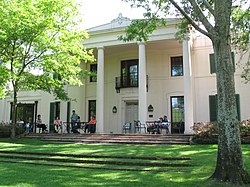Bayou Bend
|
Bayou Bend
|
|
 |
|
| Location | 1 Westcott St., Houston, Texas |
|---|---|
| Coordinates | 29°45′27″N 95°25′14″W / 29.75750°N 95.42056°WCoordinates: 29°45′27″N 95°25′14″W / 29.75750°N 95.42056°W |
| Area | 15 acres (6.1 ha) |
| Built | 1927 |
| Architectural style | Classical Revival, Other, English Regency |
| NRHP Reference # | 79002954 |
| Added to NRHP | December 6, 1979 |
Bayou Bend Collection and Gardens, located in the River Oaks community in Houston, Texas, United States, is a 14-acre (57,000 m2) facility of the Museum of Fine Arts, Houston (MFAH) that houses a collection of decorative art, paintings and furniture. Bayou Bend is the former home of Houston philanthropist Ima Hogg. Bayou Bend was marked with a Texas Historical Commission marker in 1973 and was listed in the National Register of Historic Places in 1979.
The mansion, designed by architect John F. Staub, was built between 1927 and 1928 for Ima Hogg and her brothers, William C. and Michael Hogg. Covered in towering trees and thick undergrowth, the home site was, in Miss Hogg's words, "nothing but a dense thicket". The home was one of the first to be located in the River Oaks neighborhood developed by the Hogg brothers. During construction, Ima Hogg insisted that as many trees as possible be kept. Only one tree was sacrificed to make room for the house, and the gardens were created around the existing trees. Ima Hogg gave the home its name, over the objection of her brother Will, who said the name was "too muddy and 'muskeetery' and malarial". Ima responded that "not everyone can have a bayou".
Miss Hogg created a series of gardens that were intended as outdoor rooms for living and entertaining. In 1957, Miss Hogg donated her home and her collection to the Museum of Fine Arts, Houston. Bayou Bend opened to the public in 1966.
Staub's plan for Bayou Bend combined eighteenth-century Georgian architecture with elements that are distinctly Southern and of Spanish Creole architecture. Other aspects of Bayou Bend's design are borrowed from Southern plantation houses. The interiors borrow more heavily from the architectural traditions of the North. Staub incorporated floorboards and paneling from two eighteenth-century Massachusetts houses in Miss Hogg's bedroom and sitting room. In February 1999, the city of Houston named Bayou Bend an official city landmark.
...
Wikipedia


